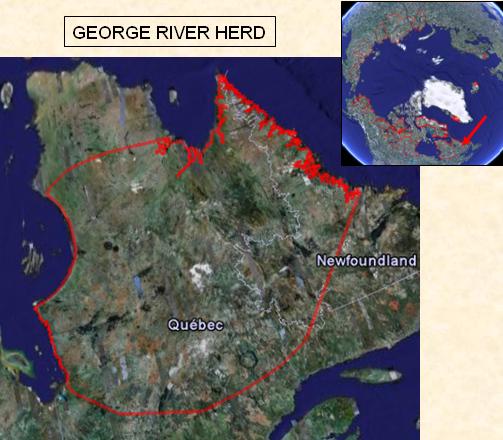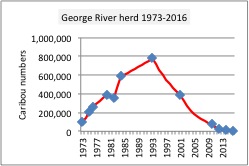
DOWNLOAD George River Herd animation (3.19 Mb) - Shows movements of satellite collared adult females between 1986 and 2005. Animation should play automatically in QuickTime Player
Status and trends: In 2016, the George herd had only an estimated 8,938 caribou. The overall trend is a 99% between the peak of 780,000 in 1993 and 2016. By 2001, the herd had declined to 385,000 caribou with a further decline to 74,131 in 2010. The rate of decline accelerated to a halving time of < 3 years as the herd was 27,000 in 2012 and 14,200 in 2014.

Ecology: Most (89%) of the annual range is below the tree line in the forest tundra zone and the summer range is relatively far south. As numbers declined, the calving ground shifted toward eastern Labrador and the winter range contracted 78% and shifted from Ungava Peninsula and the coast of Hudson and James Bay shifted east to the Labrador coast. The shift in distribution led to more accessibility to the winter ranges. Roads such as the Trans-Labrador road link Schefferville to Churchill Falls and to Goose Bay. The Voisey Bay nickel mine on the Labrador coast started operation in 2005 and hydro-electricity projects have also increased and mining exploration is increasing with 12 exploration projects in 2015 in Labrador.
The George River herd is hunted by people from Naskapi Innu communities; Labrador residents, Inuit, southern Inuit, Quebec Innu, Inuit and Naskapi and sports hunters.
As well as the parasites typical for other caribou herds, George River caribou have higher Besnoitia tarandi prevalence and are infected with the giant liver fluke. Intensity of infection is higher during spring migration and during and after the peak caribou numbers. Less is known about the effects of wolf and black bear predation on caribou especially as range sizes have contracted which affects the functional responses of the wolves.
Climate: The climate is relatively moist with high summer rainfall and winters characterized by greater snow depths days with freezing rain and exceptionally high Rain-On-Snow. March and early June snow is relatively deep and plant Growing Degree Days are low in June and July. The cooler wetter summers reduce the drought and oestrid indices. Octobers are warm with mean monthly temperature only a few degrees below freezing and significantly increasing since 1979. Other significant trends are less Rain-On-Snow and days with freezing rain and warmer, wetter Julys with increases in the oestrid index.
Monitoring: Since the 1990s, herd size is monitored through post-calving photography. Annual mortality is tracked through collars and for adult females, survival averaged 51 to 59% in 2009 – 2011 and 68.3% in 2001 – 2014 with increased survival at 79% for 2013 - 2014 (Rasiulis 2015; Coté 2014). Male survival was low 51% for 2009 - 2015 which is also reflected in the trend toward reduced percentage of large males in the fall. Between 2001 and 2006, the average was 12% large bulls but between 2007 and 2011, the average ws 4.4%. Fall calf to cow ratios annually varies with low values in 2004, 2010 – 2013 and 2015.
Body condition and reproductive performance have been extensively monitored during the herd’s increase, peak and decline in abundance (Bergerud et al. 2008, Couturier et al. 2009, Pachkowski et al. 2013). Calf birth weight averages 6.1 kg 2007 – 2011 and fall weaning weight has increased for the same period which together with increasing adult female body mass (1985 to 2009) suggests summer range is not limiting. But pregnancy rates are low at 75-77% for 1989 – 2012.
Harvests are monitoring for the resident and sports hunting in both Quebec and Labrador. In, for example, 2007/08 the combined harvest for Quebec for resident and non-resident hunting was about 5300 caribou and uncertainty remains about the aboriginal harvest.
Management: The changing body condition and reproduction suggested reduced forage started the decline in the late 1980s and early 1990s, as the herd declined; harvest rates became the accelerating factor. Uncertainties remain as the numbers are so reduced and for example, the sex age structure is distorted.
The Ministère des Forêts, de la Faune et des Parcs du Quebec and the Wildlife Division of the Government of Newfoundland and Labrador collaborate for monitoring and management. In Quebec, the Hunting Fishing and Trapping Coordinating Committee is responsible of addressing co-management issues. The HFTCC organized a caribou workshop in Montréal in January 2010 and in 2012 in collaboration with the Torngat Wildlife and Plants Co-Management Board and the Nunatsiavut Government, the HFTCC. Also in 2012, the Aboriginal Governments formed the Ungava Peninsula Caribou Aboriginal Round Table (UPCART) which includes Innu, Inuit, Métis, Cree and Naskapi from the two provinces. UPCART is developing a management strategy to work with the provincial government’s updated 2004-2010 management plan (Jean and Lamontagne 2004).
Management actions took the form of harvest restrictions: in 2009, commercial caribou licenses in Labrador were reduced by 60% and then in 2011, the resident quotas were reduced from 2 to 1 caribou per license with no transfers to another hunter and the season was reduced from 8 to 3 month season. In 2012, Quebec closed the sport hunt. In 2013, the Newfoundland and Labrador government has announced a 5-year ban on hunting caribou with a review after 2 years while, the Inuit government in Nunatsiavut and the Inuit-Metis group NunatuKavut have asked their members to abstain from hunting the George River herd for a two-year period.
Key links
Newfoundland and Labrador Department of Environment and Climate Change; Wildlife Division: http://www.env.gov.nl.ca/env/wildlife/index.html
Québec Ministere des Forêts, Faune et Parcs, Wildlife http://mffp.gouv.qc.ca/english/wildlife/index.jsp
Ungava Peninsula Caribou Aboriginal Round Table http://www.makivik.org/ungava-peninsula-caribou-aboriginal-roundtable/
JBHTFTCC 2016. The James Bay Hunting, Fishing and Trapping Coordinating Committee
http://www.cccpp-hftcc.com/eng/n-origin.htm
Caribou Ungava: http://www.caribou-ungava.ulaval.ca/en/accueil/
Literature Cited:
Bergerud, A.T., S.N. Luttich, and L. Camps. 2008. The return of Caribou to Ungava. McGill-Queen’s University Press, Montréal, QC.
Couturier, S., S.D. Côté, J. Huot, and R.D. Otto. 2009. Body condition dynamics in a northern ungulate gaining fat in winter. Canadian Journal of Zoology 87:367-378.
Mehl, K., J. Taillon and . V. Brodeur. 2012. Monitoring status of George River Herd. Downloaded from http://www.cccpp-hftcc.com/eng/n-origin.htm
Messier, F., Huot, J., Le Hénaff, D. and Luttich, S. 1988. Demography of the George River caribou herd: evidence of population regulation by forage exploitation and range expansion. Arctic 41: 279--287
Jean, D. and G. Lamontagne. 2004. Plan de gestion du caribou (Rangifer tarandus) de la region Nord-du-Québec 2004-2010. Ministère des Ressources naturelles et de la Faune. Québec City, Québec. 96 p.
Payette, S., S. Boudreau, C. Morneau, and N. Pitre. 2004. Long-term interactions between migratory caribou, wildfires and Nunavik hunters inferred from tree rings. Ambio 33:482-486.
Pachkowski, M., M. Festa-Bianchet, and S.D. Côté. 2013. Spring-loaded reproduction: effects of body condition and population size on fertility in migratory caribou (Rangifer tarandus). Canadian Journal of Zoology 91:473-479.
